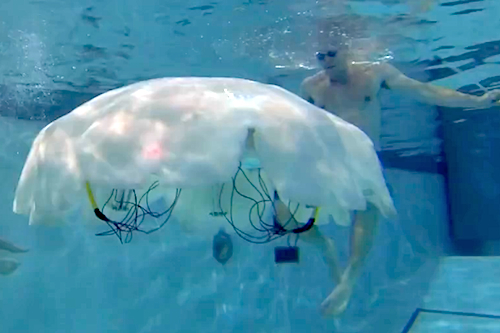Navy Invests in Giant “RoboJelly”
A perpetual hurdle in the field of robotics is motion: refining how robots travel, balance, and interact with their physical surroundings. While an overwhelming majority of roboticists continue to fixate on legs, feet and wheels that will one day carry their creations around on land, engineers at Virginia Tech and the University of Texas at Dallas have developed a robot to swim underwater instead.
 “We're dealing with a type of propulsion that's not commonly studied,” said Alex Villanueva, a graduate student in VT's College of Engineering. “Our goal with this robot is to copy the natural jellyfish.”
“We're dealing with a type of propulsion that's not commonly studied,” said Alex Villanueva, a graduate student in VT's College of Engineering. “Our goal with this robot is to copy the natural jellyfish.”
The prototype, dubbed “Cyro” is a mechanical system with eight electronically controlled arms that open the robot's artificial mesoglea (the bell-shaped silicon blanket that sits atop the jellyfish) like an umbrella.
Weighing in at 170 pounds, Cyro is hardly dainty. The robotic jellyfish gets this weight from its dimensions, which measure 5 foot 7 inches in length, along with its metal endoskeleton and nickel metal hydride battery. Still, it is able to move while expending very little energy, making it ideal for long-term underwater deployments.
And Cyro isn't the only prototype of its kind in development. As the largest of the designs that have been developed so far, the Navy-funded Cyro is intended for defense applications because it will be capable of carrying a payload. Shashank Priya, associate professor in mechanical engineering at VT noted that it's job will likely be to establish and hold an underwater position while conducting surveillance around the area.
The smaller of the two jellies we've already seen is RoboJelly, which was unveiled in 2012 and more closely resembles its animal equivalent due to its small size.
Like Cyro, RoboJelly propels itself with the same opening-and-closing mechanism as a living jellyfish, but instead uses eight movable segments that are wrapped in carbon nanotubes and coated with a platinum powder. Each segment is made from shape-memory alloys, which, when heated will curl inward, and naturally return to their original shape afterward.
“In a conventional ship you have so many moving parts and details required to move it,” said Priya. “But [with RoboJelly] you have a simple organic one doing the same performance with only three parts.”
RoboJelly will likely remain on the civilian front and be used for pollution monitoring, studying underwater species' behaviors and migration patterns, and recirculating water for oil cleanup.
Source story at Virginia Tech










